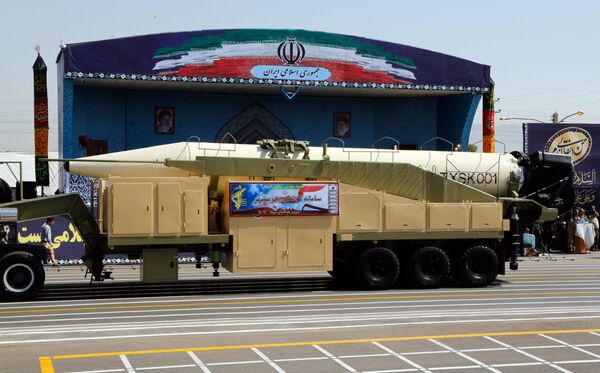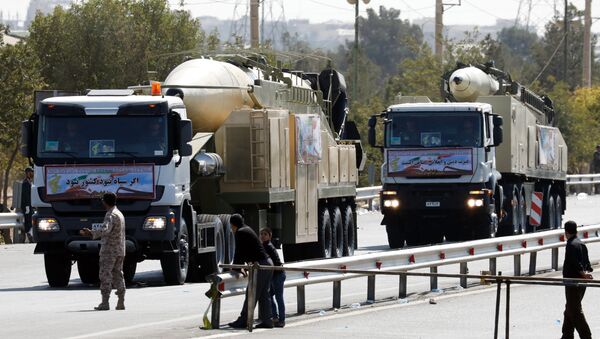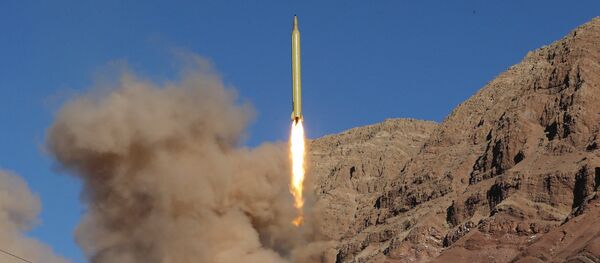Tehran won't bow down to Washington's will, despite the increasing pressure from US President Donald Trump, Emad Abshenas, an Iranian political analyst and editor-in-chief of the Iran Press newspaper, told Sputnik Persian, adding that the demonstration of the country's new "Khorramshahr" ballistic missile has come as a response to US threats.
"Experience had shown that if a country bends under US pressure, the Americans will do everything possible to increase it and gain greater benefits," Abshenas explained. "Iran stands its ground and believes that it is the US that ought to figure out its position regarding the Joint Comprehensive Plan of Action (JCPOA) [nuclear deal]: either to carry it out, or continue to rant about it."
Response to US Pressure
Following Trump's first ever speech at the UN General Assembly which contained accusations and harsh rhetoric toward Iran, Tehran unveiled the Khorramshahr ballistic missile during a military parade dedicated to the annual Sacred Defense Week.
Abshenas highlighted that for the sake of detente, Iran has long tried not to take any measures that could disturb the opposite side, and expected the lifting of all financial and economic sanctions in return.
"However, the US is not ready to fulfill its obligations," Abshenas said, adding that in accordance with the international agreements Iran has the right to develop its military and defensive capabilities in response to threats and sanctions.
"Unfortunately, some people, including Mr. Trump, understand only the language [of force]," he added.
"The fact that the new missile was named 'Khorramshahr' is of particular importance," Abshenas pointed out, "The city of Khorramshahr, was called a 'bloody city' after being liberated in the course of the Iran-Iraq war and became is a symbol of victory for the Iranians."
The political analyst underscored that following the Iran-Iraq war (1980-88), Tehran realized the necessity to develop its own weaponry and modernize its military arsenal.
While addressing the 72nd Regular Session of the UN General Assembly on September 19, Trump branded the Iranian government "a corrupt dictatorship behind the false guises of a democracy" which exports "violence, bloodshed and chaos."
He also lambasted the P5+1 nuclear agreement as "an embarrassment to the United States" and reiterated that the deal was "the worst and most one-sided transaction the United States has ever entered into."
Additionally, the US president dropped the hint that "oppressive regimes cannot endure forever" and that "the day will come and the people [of Iran] will face a choice" whether they want to "return to their proud roots as a center of civilization, culture and wealth."
Iran's ballistic missile program has triggered the discontent and concerns of other states, in particular, the United States. Despite attempts by Washington to include provisions concerning ballistic missiles in the JCPOA the proposal was not supported by other signatories.
At the end of July 2017 the US imposed new sanctions on Tehran targeting its ballistic missile program. Iran responded to the US' unilateral move by increasing the funding of the program.

The Missile's Features
Abshenas pointed out that all weapons are divided into two categories — offensive and defensive — while nuclear bombs are used by global powers mainly as a deterrent. He recalled that to date no one except the United States has ever used an atomic weapon to attack its adversaries.
According to the analyst, ballistic missiles belong in the same category and are designed primarily to deter enemies.
Capable of carrying several warheads the missile boasts an effective range of 2,000 km (1,242.7 mi) which allows the rocket to reach most of the states of the Middle East region, including Israel.
On September 23 the Press TV broadcaster reported that the new ballistic missile Khorramshahr had been successfully tested. According to the media outlet, the weapon was developed specially for the Islamic Revolutionary Guards Corps (IRGC), a branch of the Iranian Armed Forces.
"All these missiles pose a serious threat for countries that are plotting against Iran," Abshenas stressed. "A distinctive feature of the Khorramshahr rocket is that it can carry three warheads weighing up to 1800 kg."
He emphasized that as long as other countries continue to threaten Iran, the country will develop and demonstrate new models of its advanced weapons, adding that it by no means violate the terms of the JCPOA.
In July 2015, Iran and the P5+1 group of nations comprised of the United States, Russia, China, France and the United Kingdom plus Germany, signed the JCPOA, while October 18, 2015 marked Adoption Day of the agreement, when participants began taking steps to implement the Iran nuclear deal commitments.







